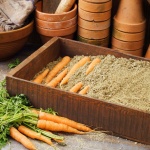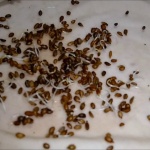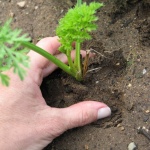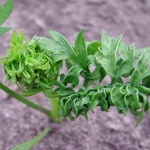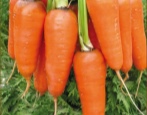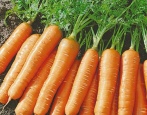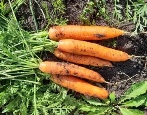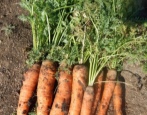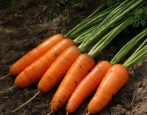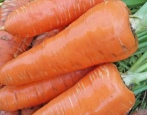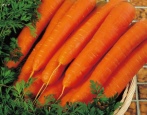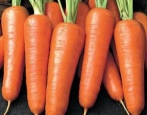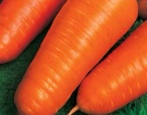
- Authors: Holland
- Year of approval: 2001
- Appointment: for fresh consumption, for canning, for freezing, for bundled products, for making juice
- Leaf rosette shape: semi-spreading
- Leaves: medium dissected, green
- Weight, g: 125-150
- The form : cylindrical, with a slightly pointed tip
- Taste qualities: good ones
- Composition : dry matter 10.6%, carotene 11.6 mg per 100 g of raw matter
- Ripening terms: mid-season
Nantes carrots were bred in Russia in 1943 and are still considered one of the best. Samson carrot was included in the Russian State Register in 2001 and has not yet managed to become so famous, but according to some indicators it is better than Nantes.
Description of the variety
The Samson carrot variety is a very fruitful and beautiful carrot. Especially interesting for commercial cultivation due to the evenness, quantity and taste of the fruit. The variety was bred in the Netherlands by Bejo Zaden B. V. in Warmenhuisen.
Characteristics of the appearance of the plant and root crops
The leaves are long, with slight pubescence, collected in a lush green rosette, not too spreading, but not narrow either. The fruits ripen underground, the shoulders do not protrude to the surface.
Root crops are cylindrical, of the same diameter along the entire length. The tip is rounded, even, slightly elongated. The shoulders are flat-rounded. The shape is correct, the commercial qualities are very high. Lined carrots, good caliber. Length 20-22 cm, diameter 4-5 cm, weight 125-150 grams, but sometimes the fruits can reach 180-200 grams. The skin and pith are orange, the flesh is juicy, uniform, the pith adheres firmly to the bark.
Purpose and taste of tubers
The taste is good, the fruits are juicy and sweet. The Samson variety is versatile, it is used fresh, is suitable for any kind of processing, it is well stored. Smooth, saturated pulp is perfectly stored in the freezer, suitable for making juice. Looks very nice on the counter in bundles - convenient for sale.
Maturation
The variety is mid-season, harvesting is carried out 110-120 days after the emergence of mass shoots.
Yield
The yield is very high, ahead of the standard Nantes 4. From 1 hectare, on average 528-762 centners of marketable Samson carrots are removed, from 1 sq. m - from 6 to 9 kg. The variety is recommended for large and small farms. The yield of marketable fruits is very high - 91-94%. Keeping quality is excellent; in cool conditions, root crops are perfectly stored until spring.
Growing regions
The variety is officially recommended for cultivation in the Central region, in the north-west of Russia, in the black earth regions, in Siberia, in the Urals and in the North Caucasus.
Growing and caring
The seeds are distinguished by good germination, so they can be sown relatively rarely, according to the scheme - 1 seed every 3 cm.They are kept between rows from 18 to 20 cm.
The place for planting Samson carrots should be sunny.
Sow in open ground at the end of April. But the term varies depending on the local microclimate and your own wishes. The usual sowing time in the middle lane is from late April to early May. The soil temperature for planting should be + 8 ° C.
Seeds are soaked in warm water before sowing. After 10 hours, all the "empty" seeds will float up. Carrot seeds are considered tightly similar to dill seeds. This is due to the content of aromatic substances in them. Any manipulation that allows you to wash out the esters from the seed shell will help accelerate germination. For example, the seeds are wrapped in a scarf and rinsed in hot water at + 55 ° C. The water is changed several times until it becomes transparent.
If the culture has been sown thickly, it is thinned out. The distance between adjacent bushes should be about 3 cm.After the appearance of a pair of real leaves, thin out again, leaving 6 cm between the plants.
Caring for Samson carrots is no different from caring for any unpretentious variety. Regular weeding and loosening will be required. Carrots can grow in dense soil, but the risk of crooked fruit increases. Weeds are competitors, they take nutrients from the root crop, the root crops become smaller.
Watering is regular, the soil should not be allowed to dry out. The taste, juiciness and size of the carrots depend on this. For irrigation, use warm, settled water, you can cool, but not cold, ice. Furrow irrigation is preferable, especially if in previous years a carrot fly has already been seen on the site. Sprinkling water will only increase the moisture that the insect loves.
When watering, the soil is well soaked up to 30 cm. A popular mistake is too shallow watering. Water penetrates up to 5-10 cm, and below the soil remains dry. In these cases, there is a risk of getting branching, "hairy" carrots. The root crop begins to form a mass of roots over the entire surface in order to extract moisture.
The most important thing in watering carrots is uniformity. The even caliber and beauty of the crop depends not only on the variety. With sharp changes in moisture, from droughts to bays, root crops crack - the core quickly picking up moisture breaks the bark. To even out the sensations of a root crop, the soil is mulched using peat, sawdust, straw, grass.
And also the type of soil should be taken into account. On clay soils in a damp summer, carrots can crack even without the "help" of a gardener. The frequency of watering is varied so that the carrots always receive approximately the same amount of moisture.
It is important not to pour the carrots. But this issue is easier to solve even at the stage of soil preparation. Loose, breathable soil with good drainage smooths out gardener mistakes. Excess moisture is quickly removed. However, it is still better not to overdo it. The higher the humidity, the higher the risk of plantings being affected by carrot flies.
Watering is stopped 2-3 weeks before harvesting.
Carrots do not need frequent fertilizers, it is enough 2 times per season. The first feeding - 4 weeks after germination, the second - 2 months later. In a bucket of water 10 liters dilute either 2 glasses of wood ash, or 15 g of superphosphate + 20 g of potassium nitrate.
From the bear, which can infect the bushes of the variety, use the drugs "Medvedotox", "Grizzly", "Nemabakt".
And also the popular enemy of culture is the carrot fly. Prevention: timely loosening, weed removal, good drainage. The pest loves to settle in thickened plantings, where the humidity is high.
For storage, the fruits of the Samson variety are placed in boxes, sprinkled with sawdust or sand, put them in a cool place.
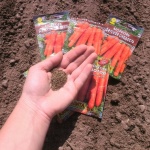
Carrots are one of the most unpretentious crops in terms of growing conditions; they can endure a short drought and a short cold snap. However, to get tasty and large root crops, you should adhere to the basic rules for planting carrots.
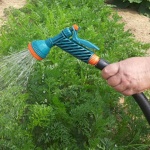
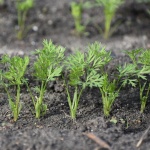
Soil requirements
The soil is light loam or sandy loam, fertile and loose. Good drainage is essential. Acidity pH 5.7-6.8. If the site has clayey dense soils, add sand and peat. Best predecessors: potatoes, cucumbers, cabbage.Do not sow carrots after dill, parsley or celery.

Carrots grow in almost any garden. There is an opinion that this culture is very resistant to all kinds of diseases and pests, but this is not the case. Without proper care, carrots become susceptible to all kinds of infections and are affected by harmful insects.
Review overview
Reviews of the Samson variety are impressive - the variety is interesting. Gardeners like carrots, many fall into the category of favorites. Unpretentious, stable, reliable variety that does not produce crooked or ugly fruits. And also very rarely there are crushed fruits or overgrowths. The carrots are juicy, without green shoulders, evenly orange. Very tasty, ideal for salads, main courses, fresh.
Most often, gardeners emphasize excellent taste, and secondly, the beauty of the fruits, their even size and large size.
Does not suffer from pests, lies well in winter, at any time you can get it and send it to the dish. Enough for the whole winter and early spring. The variety is universal, it can be sown with the expectation of early harvests, it is possible in May - to send carrots for storage as late as possible.
Of the minuses - not sweet enough. But such reviews are rare.
Samson Carrots are worth considering for anyone looking for perfectly smooth, juicy carrots with round tips.

